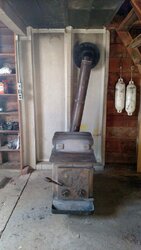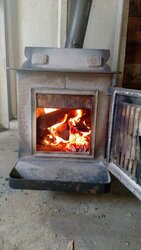Last weekend I installed a All Nighter stove that appears to be very similar in size/design to a Fisher Mama Bear into an existing 17-18 foot exterior chimney with 7" (inside) tile flue. My single wall stove pipe 90's into the chimney through a Selkirk Wall pass through. After install, I started a kindling fire in the stove and added 4 medium sized seasoned walnut splits for a test burn. At that time, I wasn't sure where to run the draft caps, so I ended up leaving them at about 3 turns out during the whole burn. I didn't have a stove pipe thermometer or infrared gun at that time (do now), but I just don't feel like the stove was getting very hot based on the fact that I could touch the stove pipe briefly without burning my hand. I never did add wood to that fire, but it seemed to be burning pretty well every time I opened the door. I plan to burn the stove again tomorrow, and think I'll try some sugar maple this time and maybe a little fuller stove. I assume the stove should get up to temp in at least 30 minutes if I'm burning good dry wood and my chimney's not sucking up all my heat, correct? This time around I also plan to monitor pipe temp just before it goes into the pass through with a stove pipe thermometer and monitor stove temp with an infrared thermometer from Harbor Freight. I gather that my goal should be to maintain at least 250 degrees on the thermometer before the pass through, and that I should see 450 plus on the stove top. There is a cleanout door on the chimney out side that is not sealed, so I figured I better seal that with some silicone so that it can't pull cool air in from the bottom.
How long for stove to come up to temperature?
- Thread starter acp104
- Start date
-
Active since 1995, Hearth.com is THE place on the internet for free information and advice about wood stoves, pellet stoves and other energy saving equipment.
We strive to provide opinions, articles, discussions and history related to Hearth Products and in a more general sense, energy issues.
We promote the EFFICIENT, RESPONSIBLE, CLEAN and SAFE use of all fuels, whether renewable or fossil.




 )
)